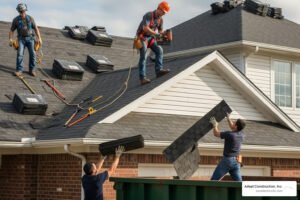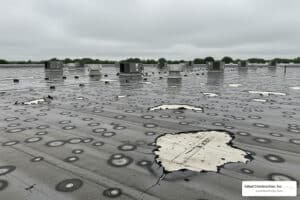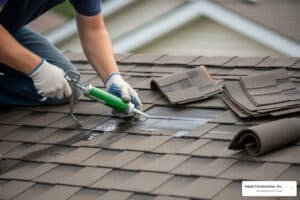
Why Understanding Roof Damage Insurance Claims Can Save You Thousands
Dealing with roof damage insurance claims after a storm can be overwhelming. The process involves specific documentation and careful navigation of policy terms that determine your settlement.
Here’s what you need to know about the roof damage insurance claims process:
- Immediate Actions – Document damage, ensure safety, and prevent further water intrusion.
- Policy Review – Understand your coverage (ACV vs. RCV), deductibles, and exclusions.
- Professional Inspection – Get a licensed roofer’s assessment before filing.
- File Promptly – Contact your insurer within policy deadlines.
- Work with Adjusters – Be present during inspections and provide thorough documentation.
- Steer Disputes – Know your options if claims are denied or undervalued.
The key to a successful claim is preparation. According to industry data, the average roof damage claim payout was approximately $5,000 in 2023, but many homeowners receive only partial coverage due to improper documentation or policy misunderstandings.
Understanding the difference between coverage types is crucial:
- Replacement Cost Value (RCV) covers full repair costs without depreciation.
- Actual Cash Value (ACV) only pays the depreciated value, often 20-25% less.
I’m Gerald Michaels, founder of Adept Construction, Inc. With nearly three decades in the roofing industry, I’ve seen that proper documentation and professional support are key to a fair settlement. Navigating the complexities of roofing insurance claims can be daunting; this guide breaks down the process.
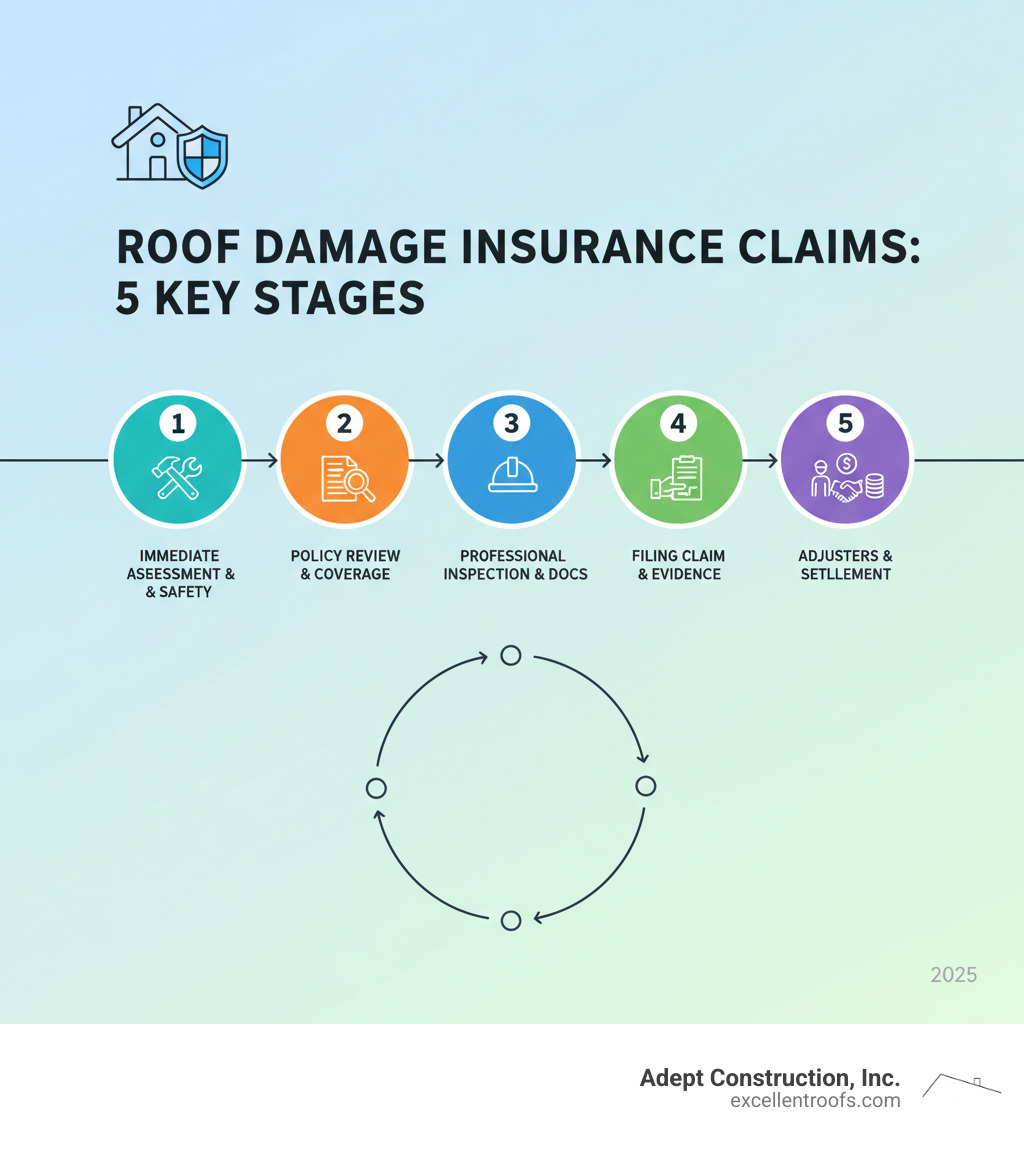
Understanding Your Policy: What’s Covered and What’s Not?
Before filing a roof damage insurance claim, understanding your policy’s language is crucial and can save you thousands. This section breaks down the essentials so you know what you’re entitled to.
Covered vs. Excluded Roof Damage
Homeowners insurance is designed to protect you from sudden and accidental damage. For example, if a tree crashes onto your roof during a storm, you’re covered. However, gradual wear from a tree branch rubbing on shingles over many years is not.
Most standard policies cover “covered perils.” Wind damage is a common claim in Illinois, as fierce storms can lift shingles and leave your home exposed. Hail damage is another major issue; even small hailstones create impact marks that knock granules off shingles, shortening your roof’s lifespan.
Fire damage to a roof is almost always covered, as are falling objects like tree branches. The weight of ice or snow can also cause structural damage that is typically covered.
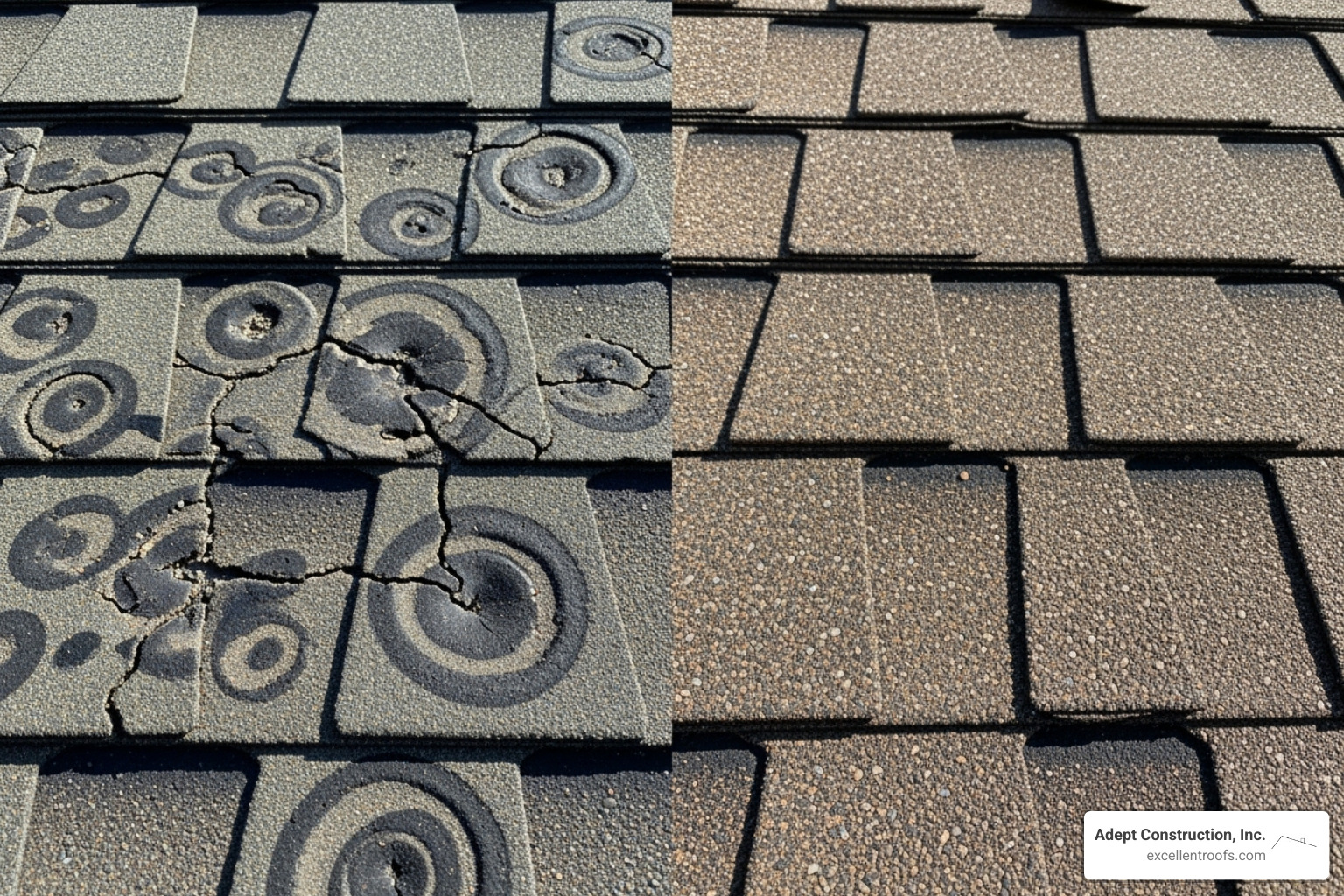
Insurance companies are clear about what they won’t pay for. Normal wear and tear is your responsibility as a homeowner. Neglect, such as ignoring a small leak until it becomes a large hole, can also lead to a denial. Poor workmanship from a previous installation is the contractor’s responsibility, not your insurer’s.
Flood damage and earthquake damage are almost universally excluded from standard policies and require separate coverage. Your policy is for emergencies, not routine maintenance. Maintaining your roof protects your investment and your insurance coverage.
Decoding Your Coverage: ACV, RCV, and Deductibles
Understanding ACV and RCV is critical for your roof damage insurance claim.
Actual Cash Value (ACV) pays the depreciated value of your roof. If your 10-year-old roof needs replacing, ACV only covers what that aged roof was worth at the time of damage.
Replacement Cost Value (RCV) is the preferred coverage. It pays the full cost to replace your damaged roof with new materials at today’s prices, without a depreciation deduction. Most RCV policies pay in two stages: an initial ACV payment, followed by the remaining amount once repairs are complete and invoiced.
| Scenario | ACV Payout (10-year roof, 50% depreciation) | RCV Payout (full cost) |
|---|---|---|
| Roof Replacement Cost: $15,000 | $7,500 (50% of $15,000) | $15,000 |
| Deductible: $1,000 | $6,500 | $14,000 |
| Your Out-of-Pocket Cost | $8,500 | $1,000 |
This table shows a $7,500 difference, highlighting why understanding your coverage is so important.
Your deductible is what you pay before insurance coverage begins. It can be a flat amount (e.g., $1,000) or a percentage of your home’s insured value for wind and hail damage. A 2% wind/hail deductible on a $300,000 home means you’re responsible for the first $6,000 of damage. Check your policy for these special deductibles for wind/hail before a storm hits.
How the Age and Condition of a Roof Affect Roof Damage Insurance Claims
The age and condition of your roof can make or break your roof damage insurance claim. Insurers view older roofs as higher risk.
If your roof is near the end of its lifespan (15-20 years for asphalt shingles), an insurer might attribute storm damage to “wear and tear” or “pre-existing conditions.” We’ve seen valid claims denied because an adjuster deemed the roof “too old.”
Regular maintenance and professional inspections protect your ability to file successful claims. A well-maintained roof with a documented inspection history is harder for an insurer to dismiss.
If your claim is approved, you may face costs to bring your roof up to current building codes. Ordinance and Law coverage is an important add-on that covers these extra expenses.
From an insurer’s perspective on risk, a newer, well-maintained roof is a lower risk. Upgrading to impact-resistant materials can sometimes lower your premiums while offering better protection. If you need guidance on your claim, our storm damage restoration team can help document damage and work with adjusters.
The Step-by-Step Guide to Filing Roof Damage Insurance Claims
Filing roof damage insurance claims is a straightforward process if you follow the right steps. Let’s walk through it together.
Step 1: Immediate Actions After Finding Damage
After finding roof damage, prioritize safety. Do not climb on the roof, as the structure could be compromised. If the home seems unstable or you suspect electrical issues, evacuate and call professionals.
Assess the damage from ground level. Look for missing shingles in your yard, dented gutters, or debris on the roof.
Your next priority is preventing further damage. If you see a leak, you must act quickly. Tarping the damaged area is a good temporary solution, but only if you can do so safely. Keep receipts for any emergency repairs, as your insurer may reimburse you for reasonable measures taken to prevent additional damage.
For more information, see our guide on the top signs your roof needs immediate repair after a storm.
Step 2: Document Everything and Get a Professional Inspection
This step is critical to your roof damage insurance claim. Document every detail thoroughly.
Take photos and videos of the damage. Use wide-angle shots for an overview and close-ups for specific problems. Also, document interior damage like water stains on ceilings or damaged drywall.
Document the date of the storm that caused the damage. Insurance companies need to connect the damage to a specific weather event. Local weather services can help establish a timeline if you’re unsure of the date.
Getting a professional inspection from a trusted local roofer is essential. An untrained eye can easily miss subtle but significant issues like hail damage. Our team knows what insurance adjusters look for and can identify all damage, differentiating between storm-related issues and normal wear. We provide thorough roof inspection services in Naperville, IL and the Downers Grove area.
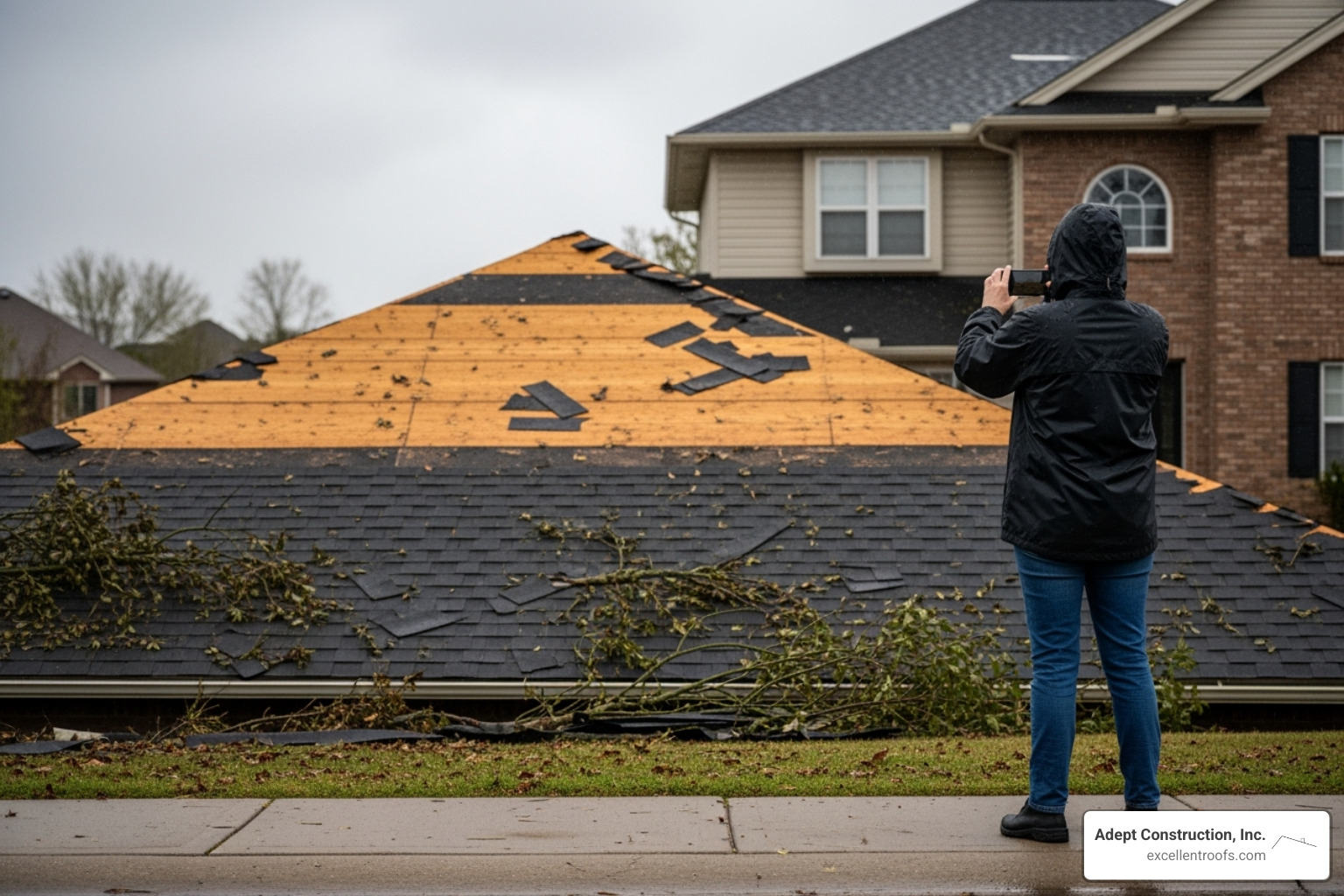
Step 3: Contact Your Insurer and Prepare the Right Information
With your documentation and professional assessment ready, it’s time to call your insurance company. First, review your insurance policy to understand your coverage limits and deductible.
Contact your insurance agent or claims department promptly. Most policies have time limits for filing, so sooner is better. Have your policy number ready and provide a clear, factual description of the damage.
When your insurer requests an estimate, a reputable contractor is invaluable. A comprehensive roof repair estimate should include detailed material specifications, itemized labor costs, clear work descriptions, realistic timelines, and warranty information. We are familiar with estimating software like Xactimate, which many insurers use.
Our estimates provide everything your insurer needs, which often speeds up the approval process and helps ensure you receive fair compensation for your storm damage restoration needs.
Navigating the Outcome: Adjusters, Denials, and Disputes
Once your claim is filed, the next phase involves working with adjusters and handling the settlement offer. Thorough preparation is your best tool for negotiation.
Working with Insurance Adjusters
Understanding the role of the adjuster assigned to your roof damage insurance claim can make a significant difference in your settlement.
The company adjuster works for your insurance company. Their job is to assess the damage and estimate repair costs based on your policy. While they should be fair, remember they are also trained to control costs for their employer.
A public adjuster, in contrast, works for you. They act as your advocate, assessing damage from your perspective and negotiating directly with the insurer. A public adjuster can be beneficial if you feel overwhelmed or your claim is undervalued.
Being present during the inspection is crucial. Have your trusted roofing contractor there to walk through the damage with the adjuster. This ensures nothing is overlooked and allows you to present your documentation, which can strengthen your position.
There are several things to avoid saying during this meeting. Never admit fault or speculate on the cause of the damage. Stick to the facts. Don’t downplay the damage; a casual remark might be used to justify a lower settlement. Be cautious about giving recorded statements without consulting a professional. Finally, don’t accept the first settlement offer, as it is often a low starting point for negotiation.
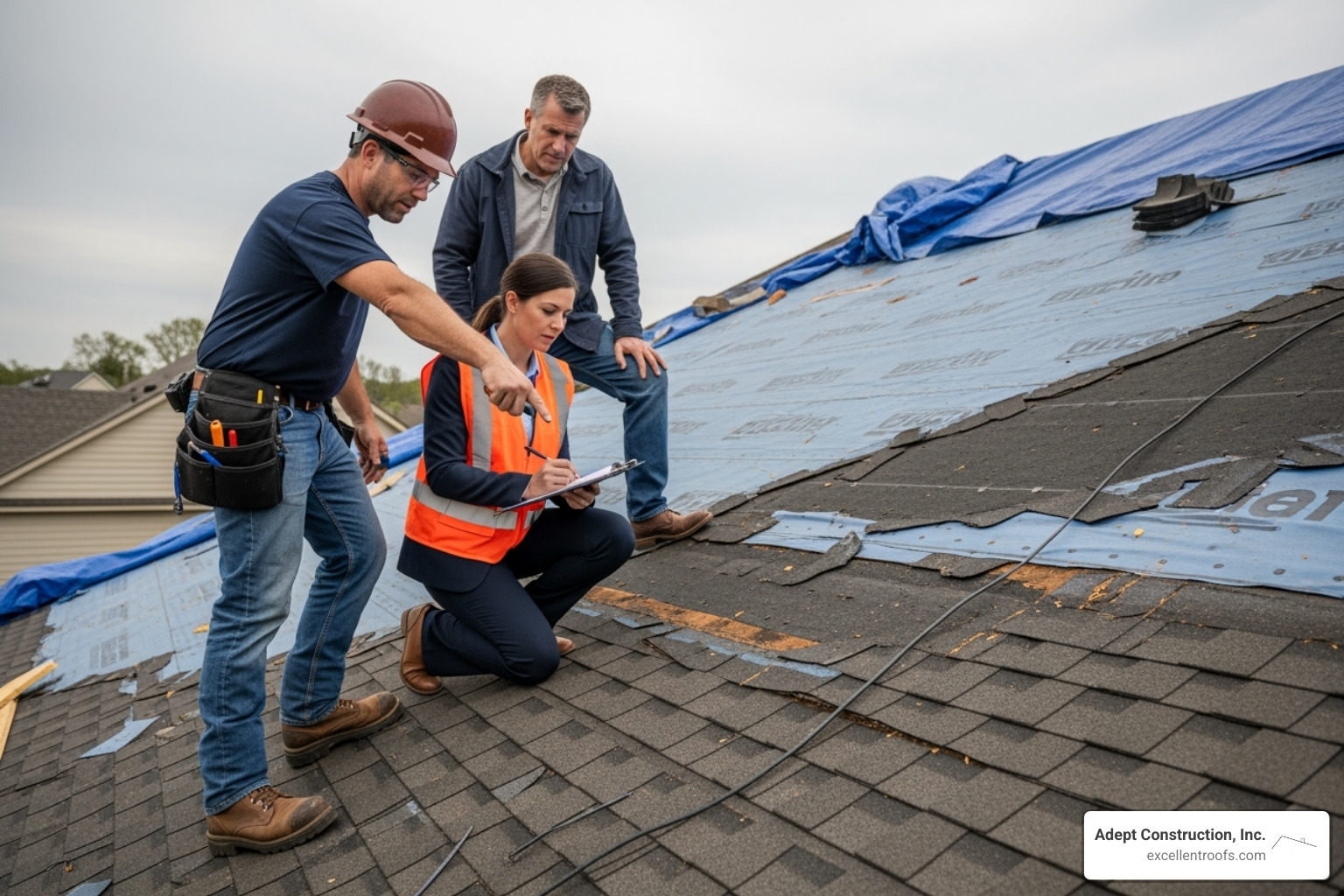
Common Reasons for Denied Roof Damage Insurance Claims
Roof damage insurance claims are sometimes denied. Understanding why can help you build a stronger case.
Insufficient evidence is a top reason for denial. If your documentation is sparse, the insurer may claim there isn’t enough proof linking the damage to a covered event.
Filing too late is another common issue. Policies have statutes of limitations, and missing these deadlines can lead to automatic denial.
Wear and tear disputes are frequent with older roofs. An insurer might argue that damage is from normal aging rather than a storm. A professional roofing assessment is invaluable for differentiating between these conditions.
Poor workmanship issues from a previous installation can also derail a claim, as the insurer will likely point to the original contractor’s warranty.
Finally, policy exclusions for events like floods or earthquakes can catch homeowners by surprise. For more details, this resource offers insights: Why Insurance Won’t Pay for Roof Damage.
How to Dispute a Denied or Undervalued Claim
A denial or low settlement offer is not the final word; it’s the start of the appeal process.
Start by reviewing the denial letter to understand the specific reasons given. This will guide your counterargument.
If the denial cites insufficient evidence, gather more compelling documentation, such as detailed photos, drone footage, or a more comprehensive contractor assessment.
Getting a second opinion from another experienced roofer can also be valuable. A fresh perspective might identify missed damage or present findings more effectively.
You can request a different adjuster if you believe the original one was biased or missed crucial details.
Many policies include an appraisal process for dispute resolution. Both you and your insurer hire independent appraisers to assess the damage. If they disagree, a neutral umpire makes a final decision.
Hiring a public adjuster is particularly useful for complex claims or significant denials. They are experts in insurance policies and negotiation, working on your behalf to secure the best possible settlement for your storm damage repairs.
Proactive Measures and Final Steps
Once your roof damage insurance claim is approved, it’s time to protect your investment for the long term. This sets you up for your roof’s longevity and smoother future insurance experiences.
Preventative Maintenance to Minimize Future Claims
A well-maintained roof is your best defense against future problems. Regular upkeep extends your roof’s life and strengthens your position for any future insurance claims.
Annual professional roof inspections are essential. Catching small issues before they become expensive problems is a smart investment. We look for loose shingles, deteriorating flashing, and other trouble spots. For guidance on timing, read How Often Do You Need a Roof Inspection?.
Gutter maintenance is critical. Clogged gutters cause water to back up under shingles, leading to water damage and ice dams. Clean them twice a year to prevent costly repairs.
Trimming overhanging tree branches prevents them from scraping against shingles and wearing them down. Heavy branches can also become projectiles during storms, causing major damage.
When replacing your roof, consider impact-resistant shingles. They withstand hail and high winds better than standard materials, and many insurers offer discounts for homes that have them.
Choosing a Contractor and Finalizing Your Claim
Choosing the right contractor after claim approval is your most critical decision, impacting both repair quality and your final settlement.
Working with a licensed local roofer like Adept Construction protects you. We understand local weather challenges in Downers Grove and Naperville and are accountable to our community. Always verify your contractor’s credentials. In Illinois, use the IDFPR license lookup tool (residential licenses start with ‘104’).
Beware of storm chasers who appear after severe weather. They often use high-pressure tactics, demand large upfront cash payments, and may perform shoddy work or disappear. Avoid any contractor who pressures you to sign immediately or can’t provide local credentials.
For homeowners with Replacement Cost Value (RCV) policies, you’ll typically receive an initial payment (ACV), then submit the final invoice to get the remaining depreciation amount. Ensure all work is satisfactory before finalizing.
Regarding claim frequency, while you should always file legitimate claims for major storm damage, multiple small claims can impact your insurance rates or lead to non-renewal. Insurers track overall claim patterns.
Frequently Asked Questions about Roof Damage Claims
After nearly three decades in the business, I’ve heard almost every question about roof damage insurance claims. Here are the most common ones with the answers you need.
How long do I have to file a roof damage claim?
The timeframe to file a roof damage insurance claim depends on your state’s laws and your specific policy. Deadlines vary, so it’s important to check both. In Illinois, you typically have more time, but don’t be complacent.
Some policies may require you to report damage within a specific period, like 30 days or one year.
My professional advice is to file as soon as you find damage. Waiting complicates the process. Adjusters will question when the damage occurred, making it harder to prove your case the longer you wait.
Will my insurance premiums go up after a roof claim?
This is a common concern. The good news is that “Act of God” events like hailstorms are typically treated differently than other claims. Many states, including Illinois, have laws preventing insurers from raising your individual premium solely due to a weather-related claim that affects an entire area.
However, if your region experiences multiple severe weather events, overall premiums may increase to reflect the higher risk. This is a regional adjustment, not a penalty for your specific claim.
Claim frequency matters more than severity. Filing one large storm damage claim is unlikely to hurt you. However, filing multiple small claims, especially for maintenance-related issues, can impact your rates or lead to non-renewal.
My recommendation is to use your insurance for its intended purpose: significant, sudden damage from covered events. Avoid filing claims for minor issues that cost less than your deductible.
Can I just pocket the insurance money?
No, you cannot pocket the insurance money without making repairs. Doing so is illegal and financially risky.
Insurance fraud is a serious crime. When you receive a payout, you agree to use that money for repairs. Pocketing the funds, especially with RCV policies, constitutes fraud, which can lead to fines, restitution, and even jail time.
RCV policies are structured to prevent this. You receive an initial payment (Actual Cash Value), and the rest is released only after you submit invoices proving the work was completed. This ensures the money is used for repairs.
Your mortgage company has a say. If you have a mortgage, your lender has an interest in the insurance proceeds and will likely require proof of repairs before releasing funds to protect their investment.
The bottom line is that insurance exists to restore your property, not to provide a windfall. For legitimate storm damage restoration, use a licensed contractor to ensure the work is done correctly and the claim is handled properly.
Get Your Roof Repaired Right in Downers Grove & Naperville
Filing a roof damage insurance claim is complex, but preparation is the key to a smooth settlement instead of a frustrating denial. By understanding your policy, documenting damage, and working with experienced professionals, you can steer the system effectively.
For homeowners in the Downers Grove, IL and Naperville, IL areas, having an experienced local roofer on your side is your best asset. We’ve seen many homeowners struggle with claims because they lacked proper documentation or tried to manage the process alone.
At Adept Construction, Inc., we help homeowners restore their roofs and peace of mind. Whether you need expert roof repair in Downers Grove, IL or roof replacement in Naperville, IL, we know how to steer the claims process.
The difference between a denied claim and a fair settlement often comes down to having the right professional support. We know how to document damage, write estimates that adjusters understand, and advocate for you throughout the process.
If you’re facing roof damage, don’t let the insurance process intimidate you. Contact us today for a free, no-obligation estimate and expert guidance on your storm damage claim. We’ll help you get the coverage you deserve and the quality repairs that will protect your home for years to come.


